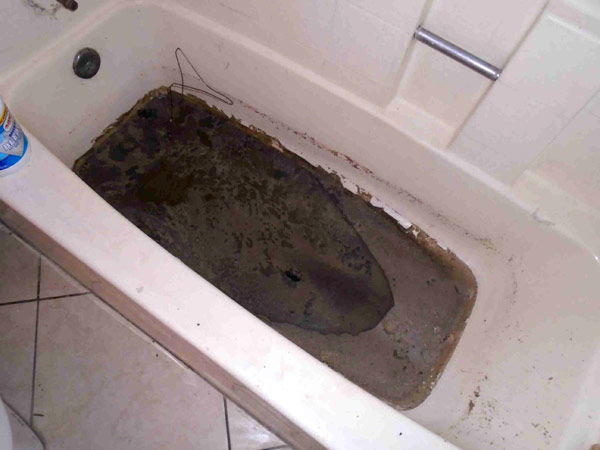An Definitive Answer: Effluent Coming Up Through the Bathtub
An Definitive Answer: Effluent Coming Up Through the Bathtub
Blog Article
The writer is making a few good points regarding Why sewage is coming up through your bathtub as a whole in this post followed below.

Sewage back-up in the tub can be an upsetting and unsanitary trouble for any kind of property owner. Not just is it bothersome, however it also positions significant wellness risks and shows underlying problems with the plumbing system. Comprehending why sewer is showing up with the bathtub is crucial for taking appropriate action to deal with the issue successfully.
Intro to the Problem
Typical Reasons for Sewage Backup
Blockages in the Sewer Line
Among one of the most usual root causes of sewer backup is a blockage in the sewage system line. This can take place because of the accumulation of particles, oil, or foreign objects in the pipelines, avoiding proper circulation and triggering sewage to support into your bath tub.
Tree Root Breach
Tree roots seeking dampness and nutrients can penetrate sewage system lines through tiny fractures or joints. Over time, these roots can expand and increase, causing substantial damage to the pipes and bring about sewage back-up issues.
Understanding the Trouble
When sewage draws back up into the tub, it's a clear indicator of a problem with the drain system. The wastewater that must be moving far from your home is instead finding its way back into your home, which can cause considerable damages and carcinogen.
Prospective Reasons
A number of aspects can contribute to sewer backup in the bathtub. From blockages in the sewer line to concerns with the plumbing framework, recognizing the source is necessary for discovering a service.
Aging Infrastructure
Older homes might have dated plumbing systems that are more vulnerable to corrosion, splits, and degeneration. As pipelines age, they become much more vulnerable to leakages and blockages, enhancing the chance of sewage backup cases.
Heavy Rainfall or Flooding
Throughout durations of heavy rainfall or flooding, the sewer system may come to be overloaded with excess water, triggering back-ups and overflows. This can cause sewage backing up right into bathtubs and other fixtures inside the home.
Indicators of Sewer Backup
Foul Odors
Unpleasant odors originating from drains pipes or components, particularly in the restroom, might suggest sewer back-up concerns. These smells are frequently strong and consistent, indicating an issue that needs immediate attention.
Slow Draining Fixtures
Bathtubs, sinks, and toilets that drain pipes gradually or otherwise in any way could be experiencing sewer back-up. If multiple fixtures are affected concurrently, it's likely that the issue stems from a common point, such as the primary drain line.
Gurgling Noises
Unusual gurgling or bubbling sounds originating from drains when water is running somewhere else in your home are indicative of air caught in the plumbing system. This air buildup can result from sewage backup and must be examined promptly.
Health And Wellness Risks Connected With Sewer Backup
Contamination of Water
Sewage backup can pollute the water in your home, presenting a significant health risk to you and your household. Direct exposure to infected water can lead to gastrointestinal problems, skin infections, and other health problems.
Mold and mildew Development
Wetness from sewage backup can develop optimal conditions for mold growth in your house. Mold spores can intensify respiratory system problems and trigger allergies in delicate people, making prompt cleaning essential.
Spread of Condition
Sewage contains unsafe germs, infections, and parasites that can create a series of illness, consisting of hepatitis, cholera, and gastroenteritis. Entering contact with sewer or infected surface areas puts you in jeopardy of infection.
Cleaning Up After Sewer Backup
Disinfection Procedures
Thoroughly sanitize and disinfect affected locations after sewer backup to get rid of harmful germs and protect against mold growth. Use ideal cleansing products and protective gear to make sure secure and effective cleaning.
Remediation of Affected Areas
Fix any type of damages to flooring, walls, or components brought on by sewer back-up. Relying on the extent of the damages, you may require to replace carpeting, drywall, or other products to recover your home to its pre-loss problem.
Immediate Actions to Take
Shutting Off Water Supply
In case of sewage backup, it's essential to shut off the water to prevent more contamination and damages. Situate the major water shutoff valve in your home and closed it off up until the issue can be resolved.
Speaking To an Expert Plumber
Dealing with sewer backup is not a DIY work. Get in touch with a licensed plumber with experience in managing sewage-related concerns to evaluate the circumstance and perform required fixings or clean-ups.
Preventing Contact with Contaminated Water
Till the sewer backup is resolved, stay clear of contact with polluted water to prevent the spread of microorganisms and microorganisms. Wear safety gear if you have to be in the affected area and clean your hands extensively afterward.
Preventive Measures
Normal Maintenance of Sewer Lines
Set up routine evaluations and maintenance of your sewage system lines to determine and deal with possible problems before they rise right into major problems. This can include clearing out particles, checking for tree origin invasion, and repairing any broken pipes.
Mounting Bayou Shutoffs
Take into consideration setting up bayou valves in your plumbing system to prevent sewage from receding right into your home during durations of heavy rainfall or flooding. These valves instantly close when water draws back up, safeguarding your home from contamination.
Appropriate Disposal of Home Waste
Stay clear of purging anything apart from bathroom tissue and human waste down the bathroom to stop blockages and obstructions in the sewer line. Dispose of oil, oil, and other home chemicals properly to minimize the risk of plumbing troubles.
Why is Sewage Coming Up Through Your Bathtub?
Reasons You May Have Sewage in Your Bathtub
All the drains in your home lead down different pipes to get to the main sewer line. If you’re seeing sewage in the bathtub, the problem is that the main sewer line is clogged up, which is causing the water running through other drains to be pushed back into other pipes. The problem isn’t the bathtub, but the main line. The sewer line can get backed up by anything that goes down the drain, from food waste, hair and soap particles to jewelry or children’s toys. Tree branches or dirt can also impact the sewer line. If you’re seeing sewage in the bathtub, you have a big problem that usually needs a professional plumber. Trying to fix this problem without the right tools or knowledge can lead to bigger plumbing problems.
Fixing a Clogged Sewage Line
Although you shouldn’t try to fix the clogged sewer line on your own, you may be able to mitigate the issue until you can get a plumber to your home. A plunger isn’t going to help, because it won’t be able to reach the sewage drain to unblock the problem.
Turn Off Water
Find the main shutoff valve to your home to turn off the water. This prevents more water from going down the drain which is only going to flow back into your bathtub.
Snake the Toilet and Drain
Start by using a drain pipe snake to clean out the toilet drain. Rotate the snake clockwise when you push the snake down. As you pull it out, the snake should spin counterclockwise. Follow up by snaking out the bathtub drain. If you are successful, both the toilet and shower will drain efficiently. If you’re not successful, you probably have a bigger problem than your tools and experience can manage.
Contact a Professional Plumber
Pros have the tools to find the source of the problem and the experience to manage big blockages without causing more damage to your pipes. It can save you a lot of stress by contacting the professionals sooner rather than later.
Identify the Early Signs of a Clogged Sewage Line
If you’re gearing up for a holiday family gathering or just want to avoid the hassle of a clogged sewage line in your home, make sure you recognize the signs of a clogged sewer line.
Slow drains are a sign of a sewer line problem. Gurgling drains from any drain in your home indicate that you may have an obstruction in the drains. If your toilet keeps getting clogged, it might be a problem with the sewer line. When you see laundry water or water from the dishwasher in different sinks in the home, it’s an indication that your sewer drain is beginning to get backed up. These symptoms can often be “fixed” temporarily to get through a day or week before you start seeing the same problem. When it comes to plumbing problems, you want to fix the root of the problem instead of muddling through. The clog will not go away on its own.
https://handymanconnection.com/mississauga/articles/why-is-sewage-coming-up-through-your-bathtub/

I am just very focused on Water Coming up Bathtub Drain and I am hoping you enjoyed my blog post. Are you aware of another individual who is fascinated about the topic? Why not promote it. Thanks for your time spent reading it.
Request Free Estimate
Report this page